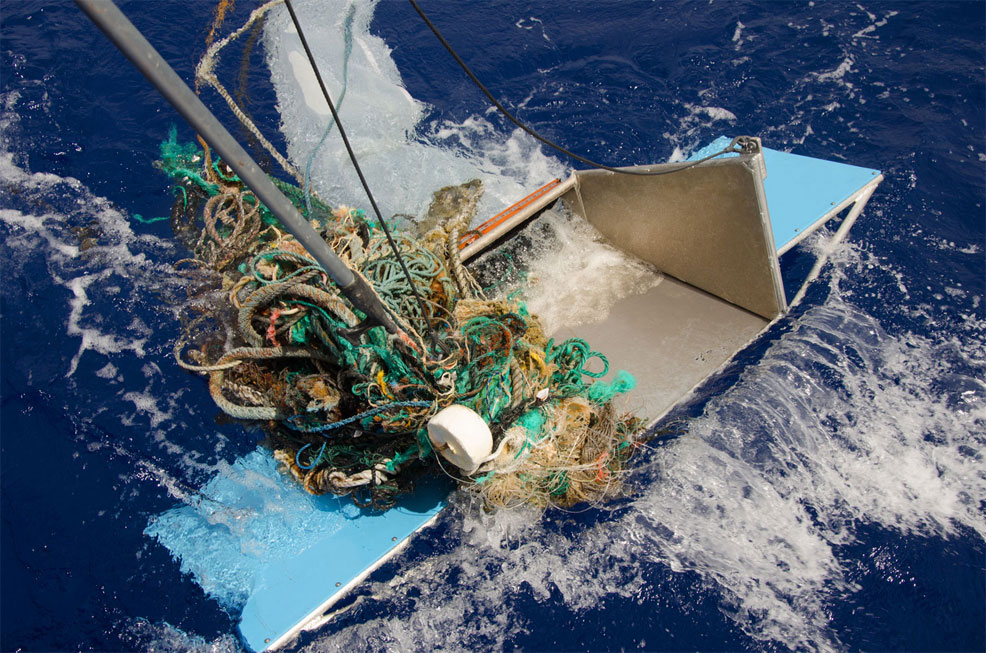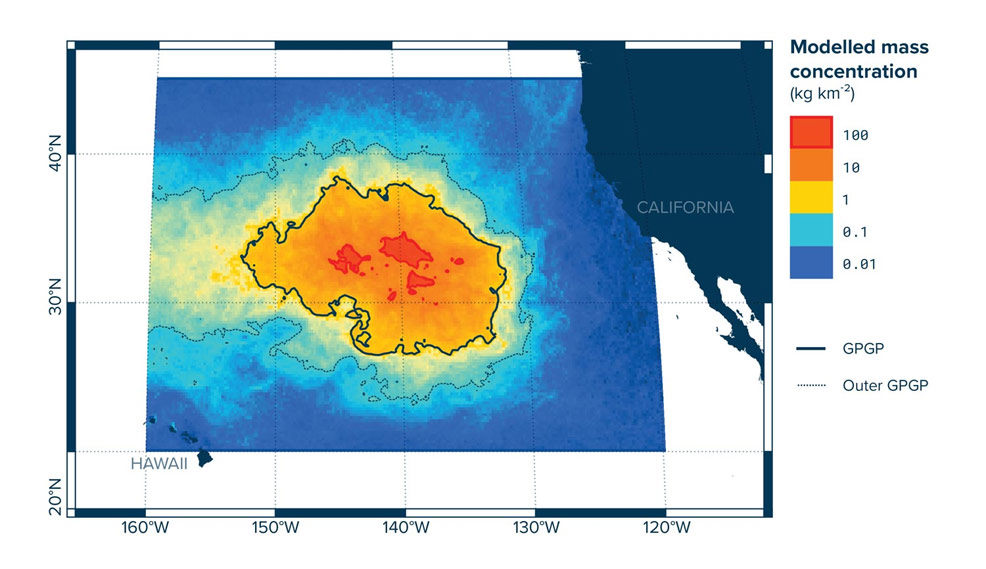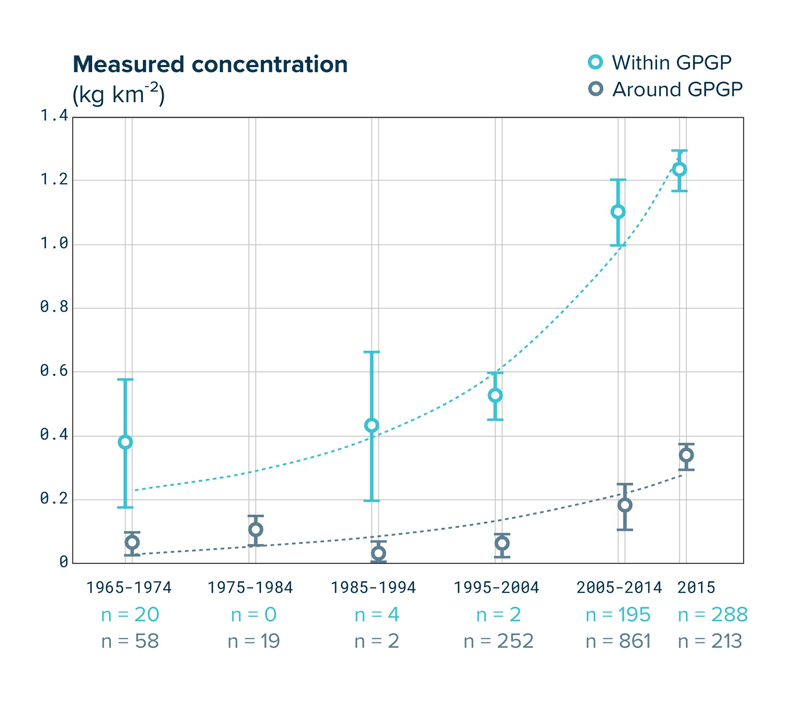
24th March 2018 Great Pacific garbage patch: 16 times larger than previously thought and "growing exponentially" About 1.8 trillion pieces of plastic weighing 80,000 metric tons are now floating in an area known as the Great Pacific Garbage Patch – and the problem is rapidly getting worse. These are the main conclusions of a three-year mapping effort by an international team of scientists from the Ocean Cleanup Foundation, alongside six universities and an aerial sensor company. Their findings are published in the peer-reviewed journal Scientific Reports. The Great Pacific Garbage Patch (GPGP), located halfway between Hawaii and California, is the largest accumulation zone for ocean plastics on Earth. Conventionally, researchers have used single, fine-meshed nets, typically less than a metre in size, to quantify the problem. However, this method yields high uncertainty because of the small surface area that is covered. Additionally, these methods could not measure the magnitude of the problem to its fullest extent, because all sampling nets – small and large – were unable to capture objects greater than the size of the net.
To analyse the full extent of the GPGP, the team conducted the most comprehensive sampling effort to date by crossing the debris field with 30 vessels simultaneously, supplemented by two aircraft surveys. While most vessels were fitted with standard sampling nets, the fleet's mothership – RV Ocean Star – trawled with two additional devices, allowing the capture of medium to large-sized objects. To increase the surface area surveyed, and quantify the largest pieces of plastic, a C-130 Hercules aircraft was equipped with advanced sensors to collect multispectral imagery and 3D scans of the ocean garbage. The fleet collected a total of 1.2 million plastic samples, while the aerial sensors scanned more than 300 km² of ocean surface. The results reveal that the GPGP, defined as the area with more than 10 kg (22 lb) of plastic per km², measures 1.6 million square kilometres, three times the size of continental France. Accumulated in this area are 1.8 trillion pieces of plastic, weighing 80,000 metric tons, the equivalent of 500 Jumbo Jets. These figures are up to sixteen times higher than previous estimates. 92% of the mass is represented by larger objects; while only 8% of the mass is contained in microplastics – defined as pieces smaller than 5 mm (0.2") in size.
"We were surprised by the amount of large plastic objects we encountered", said Dr. Julia Reisser, Chief Scientist of the expeditions. "We used to think most of the debris consists of small fragments – but this analysis shines a new light on the scope of the debris." In addition to huge amounts of discarded fishing tackle, other items found in the region included bottles, plates, buoys, ropes and even a toilet seat. "I've been doing this research for a while, but it was depressing to see," said Laurent Lebreton, oceanographer and lead author of the study. "There were things you just wondered how they made it into the ocean. There's clearly an increasing influx of plastic into the garbage patch." By comparing the amount of microplastics with historical measurements of the GPGP, the team found that plastic pollution levels have been growing exponentially since the 1970s.
Boyan Slat, founder of The Ocean Cleanup and study co-author, elaborated on the relevance of the findings for his organisation's cleanup plans: "To be able to solve a problem, we believe it is essential to first understand it. These results provide us with key data to develop and test our cleanup technology, but it also underlines the urgency of dealing with the plastic pollution problem. Since the results indicate that the amount of hazardous microplastics is set to increase more than tenfold if left to fragment, the time to start is now." "We need a coordinated international effort to rethink and redesign the way we use plastics. The numbers speak for themselves. Things are getting worse and we need to act now," added Lebreton. "We're not going to get away from plastic – in my opinion it's very useful, in medicine, transportation and construction, but I think we must divert the way we use it, particularly in terms of single-use plastic and objects that have a very short service lifespan." "We need to reduce waste and come up with new, biodegradable alternatives to plastic," said Dr Clare Steele, a California-based marine ecologist who was not involved in the research. "But one of the easiest steps is changing the way we use and discard the more ephemeral plastic products." In related news, another report published this week – Foresight Future of the Sea – warns that the amount of plastic in the world's oceans is set to triple in less than a decade, unless urgent action is taken to reduce waste. Marine pollution can have direct effects on human health, the report states, since the consumption of seafood potentially leads to ingestion of hazardous chemicals that have accumulated in the food chain. "The ocean is critical to our economic future," said one of the report's authors, Professor Edward Hill from the UK National Oceanography Centre, in an interview with BBC News. "Nine billion people will be looking to the ocean for more food."
Comments »
If you enjoyed this article, please consider sharing it:
|









